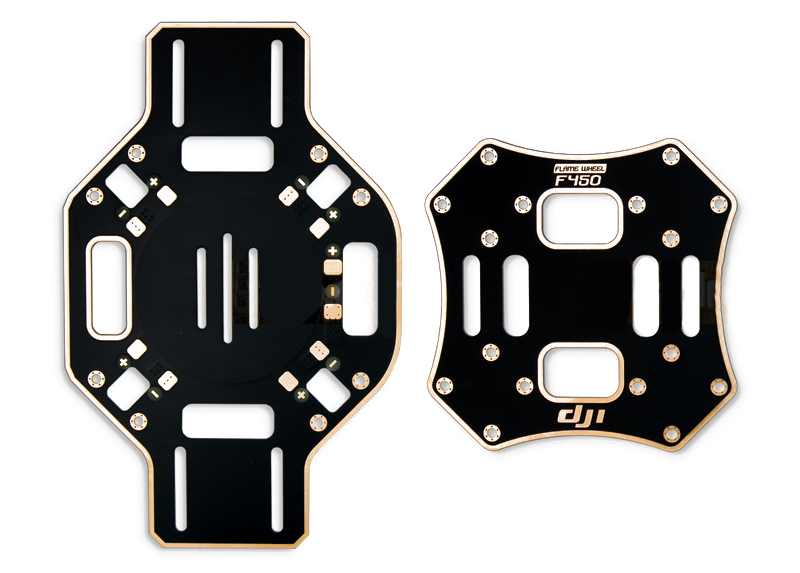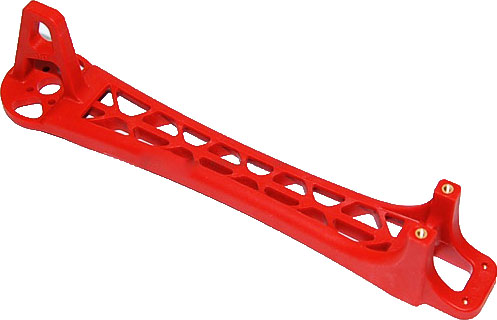Multi-Rotors, First-Person View, And The Hardware You Need
Frames And Arms: A Foundation For Success
Just as important as good electronics, multi-rotors depend on sturdy, lightweight hulls for mounting components. There are countless frame designs of varying shapes, dimensions, and materials. Stiffer frames confer better flight characteristics, since less warping and bending can occur. If a frame is too brittle, though, your inevitable crashes will result in more frequent repair sessions. Frames need to be both strong and stiff, whilst being light enough to hop around in the sky with ease.
One of the most common materials for multi-rotor frames is carbon fiber. A great many of its physical properties are perfectly suited to the hobby. The only catch is that carbon fiber is known to block radio signals, which is obviously not ideal for a hobby that depends on multiple transmissions. It can be used though, and is often. Just be aware that blocked signals are a possibility.
Frames can also be built at home using aluminum or balsa sheet. But results will vary from manufactured frames, both aesthetically and in terms of flight attributes.
Common is the integration of power distribution circuits into the frame plates. Battery connections are soldered directly to pads built into the material, and power can be tapped at other solder points without the need for extensive, messy wiring. Although by no means essential, a clean setup is satisfying and less likely to fail, making power-distributing frames a worthy investment.
Arms, too, can be built at home using aluminium or hard plastic tubing. However, for many hobbyists, it's preferable to go with pre-built arms. These components are relatively cheap and easy to replace. Therefore, they're generally considered a pre-determined breaking point. In the event of a crash, the arms should be the first to give, preventing damage to motors or expensive electronics on the frame. You actually want them to be a bit brittle, particularly on a heavier, crash-prone quad.
Arms also play a vital role in the fight against vibrations, which can cause a number of different issues. Flight controllers, with their sensitive barometers and gyroscopes, do not generally react well to incessant shaking. Jostle them too much through a poor setup and you could see erratic behavior, sometimes bad enough to cause crashes. Vibrations are also the dread of anyone hoping to use a camera on a multi-rotor. The shaking ruins footage through an artifact referred to as "jello", wavy, headache-inducing distortion formed as a result of progressive scanning.
If the arms you're using have too much flex, they can reverberate and create harmonics that are transferred across the multi-rotor. On the other hand, arms that are too stiff directly pass on vibrations without any dampening, resulting in the same problems. There is a fine balance to be found.
Get Tom's Hardware's best news and in-depth reviews, straight to your inbox.
The scale of a multi-rotor is often denoted by the horizontal width of the frame assembly, including its arms. The standard measurement is taken in millimeters from motor to motor through the center of the frame. If a model includes numbers in the title, they probably refer to this measurement. A DJI F450 is around 450 mm across, for example. The F330 is 330 mm, and so on.
Current page: Frames And Arms: A Foundation For Success
Prev Page Flight Controllers: OpenPilot, MultiWii, ArduPilot And More Next Page Motors And Propellers: Heavy Lifting-
gio2vanni86 Great article, and quite an amazing beautiful video shot at the end. Been seeing these around, and have really loved the idea of filming at a elevated level. I actually do hope you guys do more of these. I am bookmarking this for future reference. Thank you.Reply -
freiss Darn it, now you've piqued my interest. :-)Reply
As stated below, a rundown on build costs would be nice. Hey, you could even do a series of FPV articles akin to the PC builds...budget, mid-range, and enthusiast! -
Steveymoo So, how much would the components cost to lift a heavy DSLR with some decent glass? I is pretty curious.Reply -
es0 It would be awesome if you did build guides for different aircraft. I have begun building different ground based vehicles using arduinos and Pi's and would love to take to the skys next!Reply -
thechief73 Excellent article, nicely explained. Also glad to see someone in the media make a clarification from drones and multi-copters.Reply
FYI, DO NOT CALL THESE DRONES: Drones are for military use to kill people. These are, as the authors title states: multi-copters, multi-rotors, or RC model aircraft. By using the word "Drone" you give all the uneducated fear mongers and the law writers canon fodder to regulate this hobby into oblivion before it really gets a chance to take off. Some states and other countries have already passed laws that almost or outright make this hobby a CRIME!
I have been in the hobby about a year now and I have to say it is so far one of the most fun and rewarding things I have done. I will be doing this until I no longer have the means to do so. I highly recommend anyone that is interested in joining the hobby to buy a Hubsan X4 or one of the many similar RTF mini-quad models. This is widley regarded as the best way to learn how to fly a multi-rotor.
http://www.youtube.com/user/juz70/videos - not my channel, just really neat.
So, how much would the components cost to lift a heavy DSLR with some decent glass? I is pretty curious.
Just a few options: DJI S1000, SkyJib-8 Ti-QR, and CINESTAR-8.
It would be awesome if you did build guides for different aircraft. I have begun building different ground based vehicles using arduinos and Pi's and would love to take to the skys next!
Check out youtube, there are thousands of guide videos on the subject.
-
HKILLER i would highly recommend these 2 for those who that don't want to go through the trouble of the build and already have an smart device such as iphone or android ones...Reply
http://www.newegg.com/Product/Product.aspx?Item=N82E16886113011&cm_re=parrot-_-86-113-011-_-Product
and this cheaper model of it....
http://www.newegg.com/Product/Product.aspx?Item=N82E16814998083&cm_re=parrot-_-14-998-083-_-Product -
rmirwin2 There is one other regulating authority which is important to keep in mind for those seriously interested. In the US that would be the FCC, since transmission of quality RC and video signals over the available frequencies requires a Technician's class Amateur radio license. Many will find that a relatively easy thing to get that will also maximize the enjoyment of the hobby. Check in with ARRL.org, where you can get everything you need.Reply -
bluescrn Great intro to multicopters. But for beginners, it's best not to start out with a serious $500+ quadcopter, as there's a pretty good chance that you'll wreck it on it's first flight...Reply
Do yourself a favour and get a 'toy grade' mini quadcopter first, such as the Hubsan X4/Q4 Nano or similar. These are cheap, loads of fun, can be flown indoors, are much safer than the big ones, and are a great way to learn to fly a multicopter. Spend a couple of hours playing with one of these, and you'll significantly reduce the time/money spent on crash repairs when you start flying a more serious multicopter. -
bluescrn Oh, and if you go down the ready-to-fly route (or even if you self-build), try not to be the next idiot losing control of a DJI Phantom in a location where they shouldn't have been flying at all ( e.g. https://www.youtube.com/watch?v=_U8iHn_2l0U )Reply
Stick to quiet and safe flying locations, be aware of wind, line-of-sight, and possible sources of RF interference. And don't rely too much on GPS/return-to-home - you might not have a GPS lock when you need it (or it might not have had a lock at take-off, to determine the home position!)

